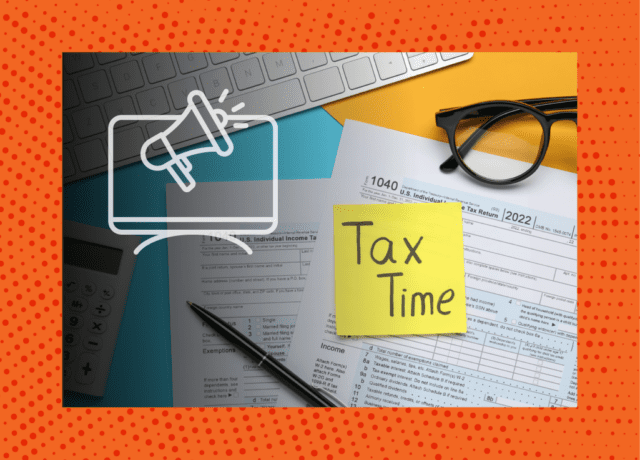As we kick off the new year, we’re covering trends from key markets in 2022. We’ll recap the state of each industry over the past year, the ad strategies of its biggest players, and what we predict 2023 will hold.
Tax service advertising is unique in the sense that companies like H&R Block and TurboTax are marching toward one day: Tax Day, which typically lands on April 15.
The unique scenario in which tax service advertisers operate begs the question: How do they spend their ad dollars since their products and services aren’t in demand year-round?
We looked at our data to find out.

MediaRadar Insights on Tax Advertising in 2022
In 2022, advertisers for tax services spent nearly $384mm on ads, representing a modest 1% YoY increase from 2021.
Most of the spending came in Q1 (77%) as advertisers pushed their products and services in the lead-up to Tax Day in April. This is the same front-loaded strategy we saw in Q1 2021 when advertisers invested 76% of their ad dollars.
Ad spending in Q1 2022
- January: Spending decreased by 16% YoY to $102mm despite the number of advertisers increasing by 31% YoY. (In contrast, January 2023 saw a 38% decrease in the number of tax service advertisers but a 5% increase in spending.)
- February: Spending increased by 30% YoY to $132mm and 29% MoM from January. The number of advertisers in February increased by 18% YoY (182 vs. 154).
- March: Spending decreased by 5% YoY to $61mm, and 54% MoM as the tax deadline approached. Meanwhile, the number of advertisers increased by 9% YoY to 153.
Predictably, spending dropped post-Tax Day. In Q2, spending from tax service advertisers decreased by 19% YoY before reigniting in Q3 and Q4 by 17% and 31% YoY, respectively, to bookend the year.
Tax Service Advertising in January 2023
If it ain’t broke, don’t fix it.
That seems to be the motto most tax service advertisers subscribed to in January 2023.
But how did advertisers allocate their budgets at the beginning of 2023?
A lot of TV ads.
Of the $108mm dedicated to national advertising in January, nearly $75mm went to TV ads (70%), especially on CBS, NBC, and Fox, which received 53% of TV budgets ($39.4mm).
The TV-heavy strategy begs another question: Who are tax service advertisers targeting?
Historically, advertisers opted for non-digital formats when setting their sights on older generations that remain fond of traditional TV; 81% of adults aged 65 years or older who responded to a survey said they receive TV via cable or satellite. Meanwhile, just 34% of those between 18 and 29 years old said the same.
Targeting more financially conscious generations with TV ads makes sense, but what about Millennials, who comprise more than 21% of the U.S. population?
That’s where online video (22% or $24mm) comes into play. In 2022, tax service advertisers invested $13.4mm (56% of online video spending) on YouTube’s gaming, music, and society & culture channels.
The OTT surge is also catching the attention of advertisers.
In January 2023, tax service advertisers spent $1.7mm on OTT ads across Peacock, Pluto TV, and Hulu (70% of OTT spending).
Spending from HRB Tax Group and Intuit
HRB Tax Group (H&R Block) and Intuit (TurboTax) were responsible for 89% of the investment from tax service advertisers in 2022, combining to spend more than $95mm.
Advertisers for these industry mainstays adopted nearly identical strategies, investing 68-70% in TV, 23-25% in social media, and the remaining in a mix of digital display and OTT.
While TV still accounted for the lion’s share of these budgets, the healthy chunk dedicated to social media could point to an evolution for tax service advertisers. As younger, social-first consumers take over their taxes, advertisers must pivot accordingly—think TikTok, Instagram, and Snapchat.
Instagram, in particular, could provide a goldmine for advertisers, with more than 60% of its users between the ages of 18 and 34. TikTok will also offer some allure, although the platform skews a bit younger, meaning a true embrace may be a few years away. According to a recent survey, around seven in 10 respondents aged between 18 and 19 years used TikTok.
The remaining 11% ($12mm) of national ad spending came from 129 tax service companies, including Jackson Hewitt, Liberty Tax and PwC. These advertisers also leaned heavily into TV (80%) while allocating 9% and 6% to digital display and print.
That said, this corner of the tax services market tapped into an ecosystem H&R Block did not: podcast ads. For these advertisers—ones clawing to steal market share—podcasts offer access to engaged niche audiences and some respite away from the two brands above that may have more ad dollars.
However, the welcomed isolation may only last for a while as HRB Tax Group and Intuit advertisers look to diversify their media mixes and reap the benefits of host-read podcast ads.
Party for Two
The tax services market is relatively large and profitable, expected to grow at a 3.9% compound annual growth rate (CAGR) between 2018 and 2023.
Despite the size, almost all of the ads from the industry come from two names: HRB Tax Group and Intuit. That’s unlikely to change anytime soon.
For the remaining advertisers—about 130—spending will continue, albeit the allocation could differ from their contemporaries at HRB Tax Group and Intuit. That may mean more dollars to podcasts, OTT, or other channels the industry giants aren’t opting for now.
For more insights, sign up for MediaRadar’s blog here.



